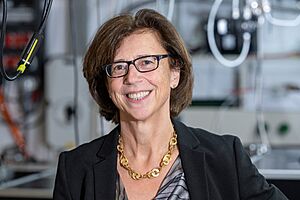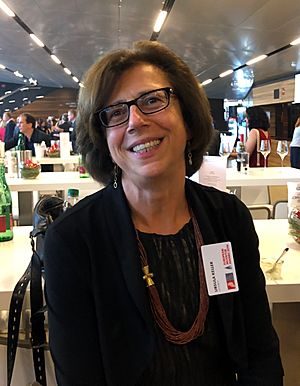Ursula Keller facts for kids
Ursula Keller, born on June 21, 1959, is a brilliant Swiss physicist. She has been a physics professor at ETH Zurich, Switzerland since 1993. She is a leader in the field of ultrafast science and technology. Dr. Keller is famous for inventing the semiconductor saturable absorber mirror (SESAM). This invention made it possible to create super-fast lasers. These lasers have changed how we use light in science and industry.
Ursula Keller also led a big research program called NCCR MUST from 2010 to 2022. This program focused on ultrafast science. She helped start companies like Time-Bandwidth Products and K2 Photonics. She has written a textbook called "Ultrafast Laser Physics." Many people have used her research in their own work. She has also won many important awards. From 2012 to 2016, she was the first president of the Women Professors Forum at ETH Zurich.
Contents
Ursula Keller's Journey in Science
Ursula Keller grew up in a family that worked hard. She earned her first degree in physics in 1984 from ETH Zurich in Switzerland. She then went to Stanford University in the United States. There, she earned a master's degree in 1987. She completed her doctorate in applied physics in 1989. Her studies focused on new ways to measure electricity in computer chips.
Early Research at Bell Labs
From 1989 to 1993, Dr. Keller worked at AT&T Bell's research center in New Jersey. She did independent research there. Her work included studying how light can switch signals. She also worked on super-fast laser technology. She developed a way to make lasers that produce very short light pulses.
Becoming a Professor
In 1993, Ursula Keller became a professor of physics at the Swiss Federal Institute of Technology (ETH Zurich). She was the first woman to become a physics professor at this school. In October 1997, she became a full professor.
Key Inventions and Discoveries
Dr. Keller's research focuses on very fast lasers. She also works on tools that create extreme ultraviolet (EUV) X-rays. Her most famous invention is the semiconductor saturable-absorber mirror (SESAM). This method creates ultra-fast light pulses. SESAMs are now used all over the world. They help with cutting and welding in many industries. These include electronics, cars, and communication. They are also used in medical tests and surgery.
Her earlier work helped develop frequency comb technology. This technology was very important for Theodor W. Hänsch and John L. Hall. They won the Nobel Prize in Physics in 2005 for their work on laser-based measurements.
The Attoclock
Ursula Keller also created the Attoclock. This is one of the most precise time-measuring devices in the world. It can measure time in attoseconds. An attosecond is a billionth of a billionth of a second. That's incredibly fast!
Leadership and Impact
From 2010 to 2022, Ursula Keller directed the Swiss National Research Centre for Ultra-fast Molecular Sciences and Technologies (NCCR MUST). This center was funded by the Swiss National Science Foundation. Since 2014, she has been a member of the Research Council for the Swiss National Science Foundation.
She has published over 500 scientific papers. Her work has been cited by other scientists more than 56,000 times. She also holds several patents for her laser inventions.
Advocating for Women in STEM
Ursula Keller strongly supports equal opportunities for women in science, technology, engineering, and mathematics (STEM). She was the first president of the ETH Women Professors Forum. This group works to support women professors at ETH Zurich.
Awards and Recognitions
Ursula Keller has received many important awards for her work.
- 1998: Zeiss Research Award for her work on powerful, ultra-short laser pulses.
- 2003: Fellow of OSA.
- 2004: Berthold Leibinger Innovation Prize for her SESAM invention.
- 2008: Joseph Fraunhofer Award / Robert M. Burley Prize for her work on ultrafast lasers.
- 2013: Arthur L. Schawlow Award, the highest award from the Laser Institute of America.
- 2014: Fellow of the Institute of Electrical and Electronics Engineers (IEEE) for her contributions to laser physics.
- 2015: Charles Hard Townes Award for her work on lasers and frequency comb technology.
- 2017: Weizmann Women and Science Award for her contributions to ultrafast lasers and attosecond science.
- 2018: European Inventor Award in the "Lifetime achievement" category.
- 2018: IEEE Photonics Award.
- 2019: IEEE Edison Medal.
- 2020: SPIE Gold Medal, the highest honor from the Society of Photo-Optical Instrumentation Engineers.
- 2020: Frederic Ives Medal/Quinn Prize from The Optical Society for her work on ultrafast lasers.
- 2021: Elected as an international member of the National Academy of Sciences, USA.
- 2022: Marcel Benoist Prize, sometimes called the "Swiss Nobel Prize."
- 2025: Foreign Member of the Royal Society.
See also
 In Spanish: Ursula Keller para niños
In Spanish: Ursula Keller para niños



